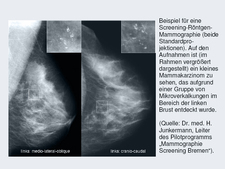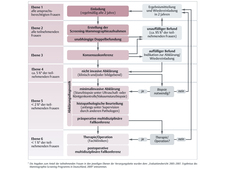-
Topics
subnavigation
Topics
Electromagnetic fields
- What are electromagnetic fields?
- Static and low-frequency fields
- Radiation protection relating to the expansion of the national grid
- High-frequency fields
- Radiation protection in mobile communication
Optical radiation
Ionising radiation
- What is ionising radiation?
- Radioactivity in the environment
- Applications in medicine
- Applications in daily life and in technology
- Effects
- What are the effects of radiation?
- Effects of selected radioactive materials
- Consequences of a radiation accident
- Cancer and leukaemia
- Genetic radiation effects
- Individual radiosensitivity
- Epidemiology of radiation-induced diseases
- Ionising radiation: positive effects?
- Risk estimation and assessment
- Radiation protection
- Nuclear accident management
- Service offers
-
The BfS
subnavigation
The BfS
- About us
- Science and research
- Laws and regulations
- BfS Topics in the Bundestag
- Links
The German Mammography Screening Programme

![]() X-ray mammography image
Source: Dr. med. H. Junkermann
X-ray mammography image
Source: Dr. med. H. Junkermann
With about 70,000 newly diagnosed cases per year, breast cancer is the most common type of cancer found in women in Germany. In spite of major progress in the field of breast cancer treatment, about 17,000 women die from this disease every year.
For the diagnosis of breast cancer there are - after recording the medical history of the patient (anamnesis) and after visual inspection and palpation of the breast by the physician - three imaging techniques:
- X-ray mammography (X-ray examination of the breast),
- sonography (ultrasound scan),
- magnetic resonance imaging (MRI).
X-ray mammography (short: mammography) is the method of choice particularly for older women (after menopause). Sonography and MRI are specifically used in younger women or as supplementary diagnostic methods for the clarification of an abnormal mammogram finding.
Options for breast cancer prevention, for example by a health conscious lifestyle, are very limited. For this reason, the early detection of breast cancer is of major importance. The goal is to detect early-stage non-palpable malignant tumours since there are good chances of cure at this stage. Mammography (see image) is currently considered the most effective method for the early detection of breast cancer in women aged 50 to 69 years.
Goal of a Mammography Screening Programme (MSP)
Regular quality-assured mammograms are aimed at reducing breast cancer mortality rate in the long term. Exposure due to the associated X-radiation should be as low as possible.
Preparatory work for a MSP in Germany
Starting from 2001, regional pilot projects were performed to test the general set-up of a programme for mammography screening. On account of positive preliminary results, the German Bundestag decided to introduce a nationwide MSP in compliance with the strict European Guidelines for Quality Assurance in Breast Cancer Screening and Diagnosis in 2002.
Subsequently, legal regulations (modification of the German Guideline for the Early Detection of Cancer and of the Federal Collective Agreements) had to be drawn up for this purpose. In the process, the Federal Environment Ministry (BMU) and the Federal Office for Radiation Protection (BfS) advocated high quality standards particularly with respect to radiation protection.
The German MSP

![]() Structure of the Mammography Screening Programme in Germany
Source: Qualitätsbericht 2005-2007, edited by Kooperationsgemeinschaft Mammographie
Structure of the Mammography Screening Programme in Germany
Source: Qualitätsbericht 2005-2007, edited by Kooperationsgemeinschaft Mammographie
The Kooperationsgemeinschaft Mammographie KoopG (Institution for the coordination of the German MSP) was established in 2003 for the gradual implementation of the MSP. Figure 2 gives an overview of the structure of the MSP in Germany.
In 2005, the first screening unit (SE) was certified and began operation. Every SE is headed by one or two physicians in charge of the programme (PVA) and can be made up of several sites, the "mammography units" (ME). In 2009, the last of a total of 94 screening units went into operation.
Dedicated regulations specify the quality-assured MSP process. They are based on the strict European Guidelines:
- All women aged 50 to 69 years without any clinical suspicion of breast cancer are invited to attend mammography screening every two years. Together with the letter of invitation, the women receive a standardised medical history information sheet which has to be filled in before examination.
- The mammograms are then taken in the SE where both medical technical staff and mammography system equipment have to meet high quality standards.
- These mammograms are read independently by two physicians ("double reading") who both have professional experience of at least 5,000 mammogram readings per year. In the case of discordant findings, the mammograms are evaluated in a consensus review involving the PVA.
- If further clarification is required, the first step is a clinical and imaging examination. If this evaluation reveals the suspicious finding, a "minimally invasive biopsy" is performed, that is, a tissue sample is removed as carefully as possible and is examined.

![]() Flowchart of the screening chain
Source: Qualitätsbericht 2005-2007, edited by Kooperationsgemeinschaft Mammographie
Flowchart of the screening chain
Source: Qualitätsbericht 2005-2007, edited by Kooperationsgemeinschaft Mammographie
High quality standards along the entire "screening chain" (see flowchart) are ensured, among other things, by
- recertifying the screening units at regular intervals,
- regular participation in further training programmes of all personnel involved in screening,
- using standardised protocols for performing mammograms as well as for any necessary recall of women and subsequent further diagnostics and
- regular assessment of the programme (programme evaluation).
Regular review and analysis of the MSP
In accordance with the German Guideline for the Early Detection of Cancer, the MSP is reviewed and analysed regularly in terms of process and outcome quality. In this context, the European Guidelines have specified certain parameters, such as
- participation rate
- how often could breast cancer be detected by the screening programme?
- proportion of small, localised carcinomas (so-called "ductal carcinoma in situ" (DCIS)) or larger invasive carcinomas.
The results are summarised in quality and evaluation reports at regular intervals. These reports can be consulted on the website of the KoopG.
The overall goal of the programme is a sustainable reduction in breast cancer mortality. Whether this goal is achieved by the German programme will also be investigated as part of a research project. This mortality evaluation will be part-funded by the Federal Environment Ministry, the Federal Ministry of Health as well as the KoopG. The leading research contractor is the University of Münster. At first, it is currently being tested within the scope of a feasibility study whether, and if so, how an evaluation of breast cancer mortality can be realised. The feasibility study began in July 2012 and lasted two years. It has been followed by an extended feasibility phase of 1.5 years since January 2015.
State of 2017.04.26


